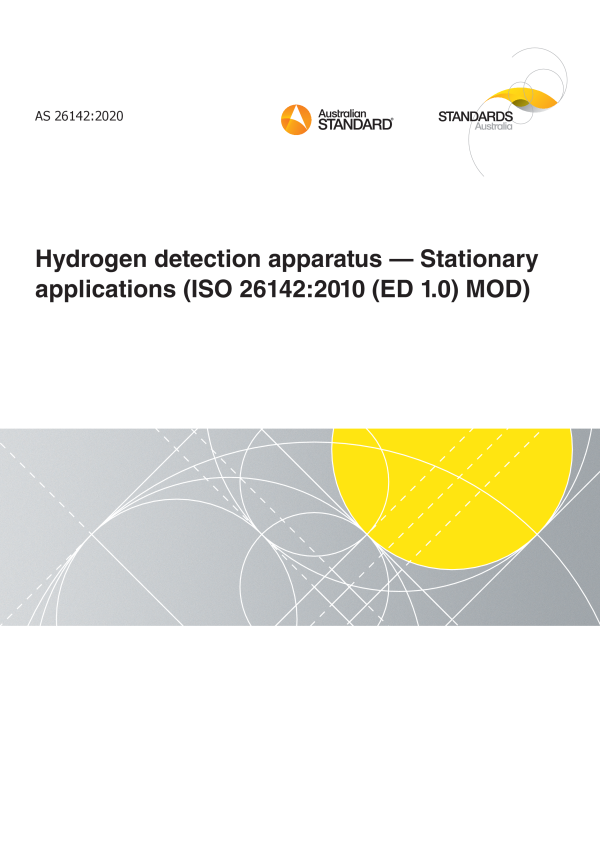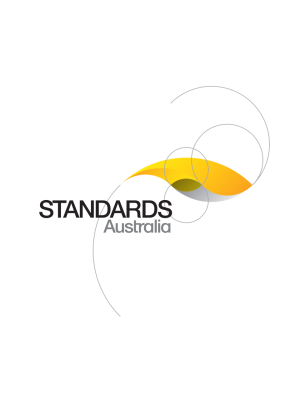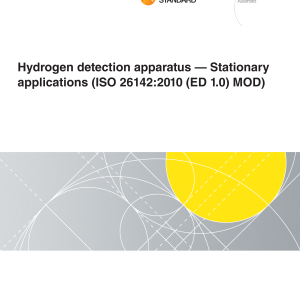🔍

Purchase the full subscription package now and enjoy a 40% discount, along with free updates for future editions.
AS 26142:2020
$125.14
Hydrogen detection apparatus — Stationary applications (ISO 26142:2010 (ED 1.0) MOD)
This Standard adopts ISO 26142:2010 with modifications for Australia, It defines the performance requirements and test methods of hydrogen detection apparatus that is designed to measure and monitor hydrogen concentrations in stationary applications.
Table of contents
Header
About this publication
Preface
Foreword
Introduction
1 Scope
2 Normative references
3 Terms and definitions
4 General requirements
4.1 Construction
4.1.1 General
4.1.2 Enclosure
4.1.3 Measuring range
4.1.4 Alarm system
4.1.4.1 Alarm
4.1.4.2 Fault signals
4.1.5 Indicators
4.1.5.1 Power indication
4.1.5.2 Signals for recording
4.1.5.3 Measuring range
4.1.5.4 Indicating colours
4.1.6 Adjustments
4.1.7 Software-controlled hydrogen detection apparatus
4.1.7.1 General
4.1.7.2 Conversion errors
4.1.7.3 Special state indication
4.1.7.4 Software
4.1.7.5 Data transmission
4.1.7.6 Self-test routines
4.1.7.7 Functional concept
4.1.8 Reliability
4.2 Labelling and marking
4.3 Instruction manual
4.4 Vibration
5 Performance requirements
6 Tests
6.1 General requirements for tests
6.1.1 Number of samples
6.1.2 Sequence of tests
6.1.3 Preparation of the hydrogen detection apparatus before testing
6.2 Test equipment
6.3 Normal test conditions
6.3.1 Temperature
6.3.2 Pressure
6.3.3 Humidity
6.3.4 Voltage
6.3.5 Orientation
6.4 Test methods
6.4.1 General
6.4.2 Standard response test
6.4.2.1 Standard test gas
6.4.2.2 Procedure
6.4.3 Measuring range and calibration
6.4.3.1 Initial preparation of the hydrogen detection apparatus
6.4.3.2 Validation of accuracy (calibration curve)
6.4.4 Stability
6.4.4.1 Repeatability
6.4.4.2 Long-term stability
6.4.5 Alarm set point(s)
6.4.5.1 General
6.4.5.2 Increasing hydrogen volume fraction
6.4.6 Temperature
6.4.6.1 Test condition
6.4.6.2 Requirement
6.4.7 Pressure
6.4.8 Humidity
6.4.9 Vibration
6.4.9.1 Test equipment
6.4.9.2 Procedures
6.4.9.3 Vibration levels
6.4.9.4 Tolerance
6.4.10 Orientation
6.4.11 Flow rate for aspirated apparatus
6.4.12 Air velocity
6.4.12.1 Test condition
6.4.12.2 Requirement
6.4.13 Time of response and time of recovery
6.4.14 Selectivity
6.4.15 Poisoning
6.4.16 Operation above the measuring range
6.4.17 Power supply variations
6.4.18 Power supply interruptions, voltage transients and step changes of voltage
6.4.18.1 General
6.4.18.2 Short interruption of power supply
6.4.18.3 Voltage transients
6.4.18.4 Step changes of voltage without interruption
6.4.19 Warm-up time after restart
6.4.20 Electromagnetic immunity
6.4.21 Field calibration kit
6.4.21.1 Test condition
6.4.21.2 Requirement
Annex A
A.1 Basic set up
A.2 Standard response test
A.3 Time of response and recovery
Annex B
B.1 Selection of the series or parallel arrangements
B.2 Series arrangement
B.3 Parallel arrangement
B.4 Advantages and disadvantages of the flow-through test method
B.4.1 Advantages
B.4.2 Disadvantages
Bibliography
Appendix ZZ
ZZ.1 Scope
ZZ.2 Variations
Cited references in this standard
Please select a variation to view its description.
| Published | 16/10/2020 |
|---|---|
| Pages | 27 |
Please select a variation to view its pdf.


